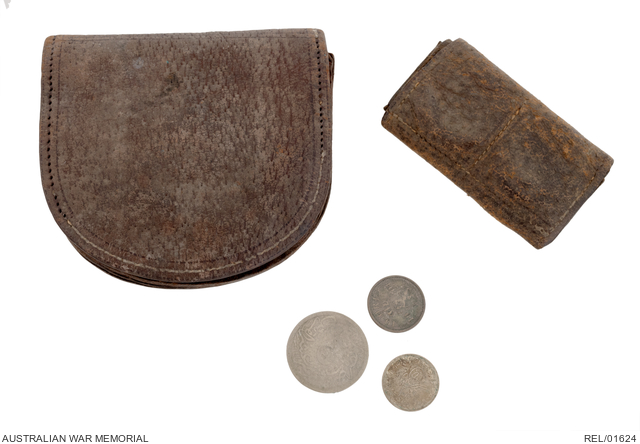| Accession Number | REL/01624 |
|---|---|
| Collection type | Heraldry |
| Object type | Heraldry |
| Physical description | Leather |
| Maker |
Unknown |
| Place made | Australia |
| Date made | c 1914 |
| Conflict |
First World War, 1914-1918 |
| Source credit to | This item has been digitised with funding provided by Commonwealth Government. |
Purses : Corporal Arthur G Alderdice, 2 Battalion, AIF





Two small brown leather purses. The larger is 75 x 70 mm leather purse with metal snap button. It has two gusseted pouches and a slim compartment with flap. The smaller purse is rectangular and measures 56 x 33mm. It folds out to 120mm and has holders for six coins. There are imprints on each holder where coins were kept. This collection includes three coins; one smooth [probably Egyptian] coin, one 10 ore Swedish coin 1901, and a one piastre coin from Egypt.
Arthur Gladstone Alderdice was born in 1881. A woolscourer from Chatswood, Sydney, Alderdice enlisted in the AIF on 6 April 1915. He was given the regimental number 2101 and allotted to the 6th Reinforcements of the 2nd Battalion
He arrived at Liverpool Camp on 23 April 1915, where he undertook training for six weeks before embarking for active service. Alderdice’s diary records boarding the transport ship Karoola on 16 June and arriving in camp at Heliopolis on 18 July. Not long after, Alderdice sailed for Lemnos, arriving on Gallipoli on 6 August at 1 am, and going into the firing line at 5pm. Alderdice spent the next four months in the trenches of Gallipoli, promoted to Lance Corporal on 7 November 1915.Suffering from diphtheria, Lance Corporal Alderdice was taken off the peninsular in early December. Hospitalised in Malta, Alderdice arrived back to Cairo on 18 February 1916. The following month he rejoined his unit and embarked for France on the SS Ivernia, disembarking in Marseilles on 28 March with the rank of Corporal. On 1 June his Battalion was reviewed by Prime Minister Billy Hughes, and the following week Alderdice went into the trenches near Fleurbaix. On 24 July Alderdice was wounded severely, suffering gun shot wounds to the head, hand, arms and legs. He was invalided to Rouen, then transferred by hospital ship St Andrew to England, arriving for treatment at 3 London General hospital six days after wounding on 30 July. Arthur Alderdice succumbed to his wounds, dying on 15 August 1916. He was buried at the Wandsworth Cemetery, leaving behind a wife and young son.